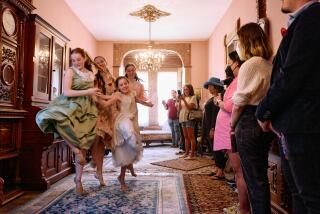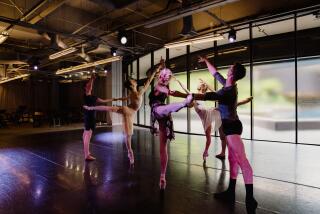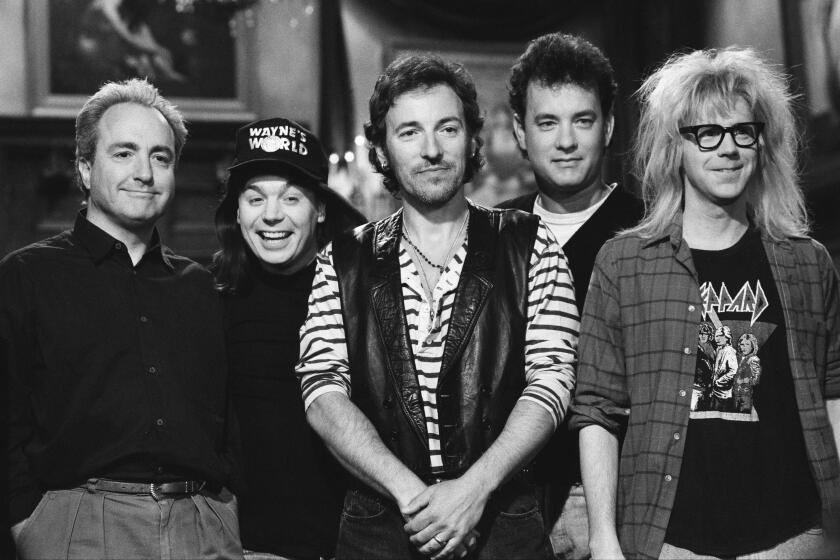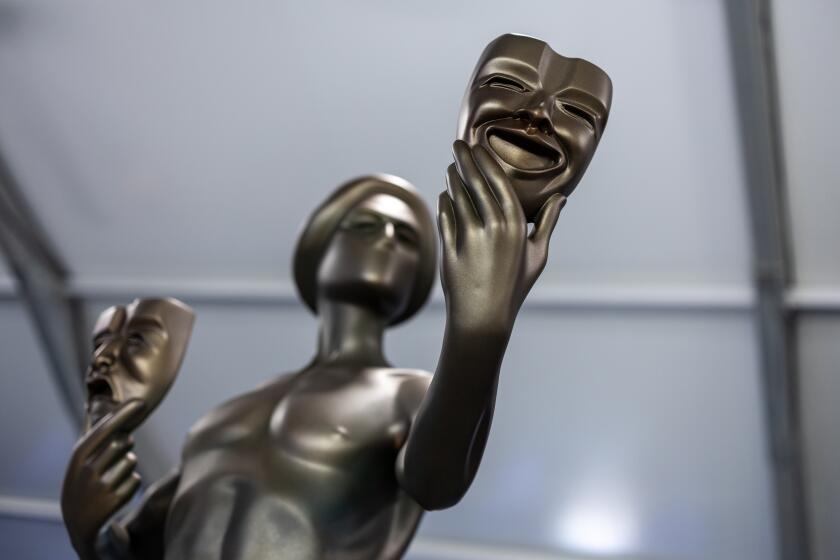Trisha Brown’s Solo Highlights Program
- Share via
In her 10-minute solo “If you couldn’t see me,” legendary choreographer Trisha Brown dances on the stage of the Veterans Wadsworth Theater on Friday facing upstage but sustaining her free-spirited, torso-twisting, arm-swirling gambits so skillfully that not seeing her face becomes only an incidental matter. Remember Fred Astaire in silhouette? Brown is that distinctive, indeed, inimitable, with her back turned.
At age 60, Brown lets her restless arms pull her slender torso into new movement adventures as easily as when she founded her company 27 years ago, and she remains exemplary for integrating so much body and brain into a disarmingly light and articulate style. While she dances “If you couldn’t see me” in her Robert Rauschenberg dress to a recorded wash of tones composed by Rauschenberg, her stature as the whimsical matriarch of postmodernism remains undiminished--but it’s the freshness and immediacy of the performance you carry away.
That’s exactly what’s missing in the two recent group pieces for her 10-dancer ensemble: freshness and immediacy. Crafted with great intelligence, they represent Brown’s evolving (though not necessarily deepening) postmodern aesthetic and thus have considerable academic interest. However, in the most fundamental sense they’re studied and remote, relics from another era no matter what their dates of creation, and you’re not surprised at how many ticket-holders leave at intermission.
A suite from “M.O.” (1995) proves especially problematic. In a rare foray into music visualization, Brown takes on Johann Sebastian Bach--and loses, principally because there’s a dimension to his work beyond formal structure and sheer intricacy that she attempts to physicalize only at the end in an intense solo for Diane Madden set against weighty group movement. Otherwise it’s clockwork Bach: endlessly twitchy, dodgy, metrical and soulless.
In the final sequence, Madden wears white and the group black--with contrasts and changes between these extremes forming a major motif throughout the piece. Designed by Irie, the gauzy capes over tight, revealing dance-wear sometimes serve as transitions between black and white, elsewhere as evocations of period robes.
Similarly, Brown suggests antique court-dance decorum by imposing a rigid upper torso on her nine-member cast, with the rapid-unto-manic footwork highlighting the block-like immobility above. But the recorded Bach accompaniment has a life that the merely animated dancing never approaches, and Brown only really succeeds in bridging past and present in moments of stillness.
In the livelier “For M.G.: THE MOVIE” (1991), Brown and her collaborators play perceptual pingpong, with Alvin Curran’s score juxtaposing conventional music with blocks of environmental sound and Brown’s choreography featuring both highly technical passages and lots of natural motion: an endless jogging solo by Gena Rho at the beginning, for example.
There’s also plenty of swirling stage smoke (artfully lit by Spencer Brown) versus overhead spotlights in the auditorium aimed down at members of the audience--a device that puts a documentary frame around the dancing by making you notice the people watching it. So we’ve got the random, formless, mundane real world and the artificial, stylized, artsy dance world in dozens of low-impact collisions, with Ming Lung Yang standing with his back to the audience throughout the piece--perhaps watching Brown dance “If you couldn’t see me” somewhere even further upstage.
Much of the dancing seems pointlessly methodical here--reliable but faceless, even with all the faces facing front--though Madden has another solo at the end brimming with feeling and even mystery. There are also gorgeous shimmering effects in Curran’s music complemented by finely wrought execution by the dancers: floating balances-in-extension undisturbed by major shifts in torso position, for instance.
Extreme slow-motion also unfazes these dancers but they never have the same freedom that Brown allows herself to ride the moment or be swept away by it. Maybe local audiences have been spoiled by the perfect unisons and indomitable individuality of the dancers in the three Nederlands Dans Theater ensembles, but the Trisha Brown Company looks awfully locked down expressively these days. And corseted, impersonal postmodernism is no postmodernism at all.
More to Read
The biggest entertainment stories
Get our big stories about Hollywood, film, television, music, arts, culture and more right in your inbox as soon as they publish.
You may occasionally receive promotional content from the Los Angeles Times.










